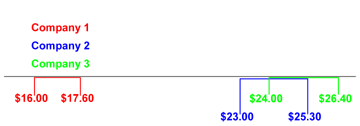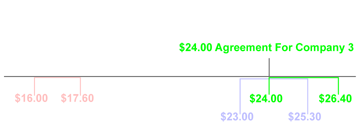If the current contract expires during the year, your company establishes a bargaining position that is bounded by a Starting Position and Negotiation Ceiling.
The Starting Position (first) wage offer cannot be less than 80% or more than 150% of your current contract. The Starting Position for Benefits, Profit Sharing, and Annual Raise can be between 0% and 150% of your current contract.
The spreadsheet automatically enters a Negotiation Ceiling that is 10% above each Starting Position.
Each company will have its own Starting Position and Negotiation Ceiling for the four categories. The example below shows Hourly Wages Starting Positions and Negotiation Ceilings for three companies (figure below):
- Company 1 has a Starting Position of $16.00 and a Ceiling of $17.60;
- Company 2 has a Starting Position of $23.00 and a Ceiling of $25.30;
- Company 3 has a Starting Position of $24.00 and a Ceiling of $26.40.

Labor will ask for a 10% across the board wage and benefit increase. For example, if the wage were currently $20.00 per hour, labor demands $22.00 per hour.
However, if any of the Starting Position offers is higher than the 10% increase, labor will adjust its demand upward to match it. Company 3’s Starting Position for wages is $24.00, therefore labor now demands $24.00 from all companies. Labor accepts Company 3’s offer of $24.00 per hour (figure below).

